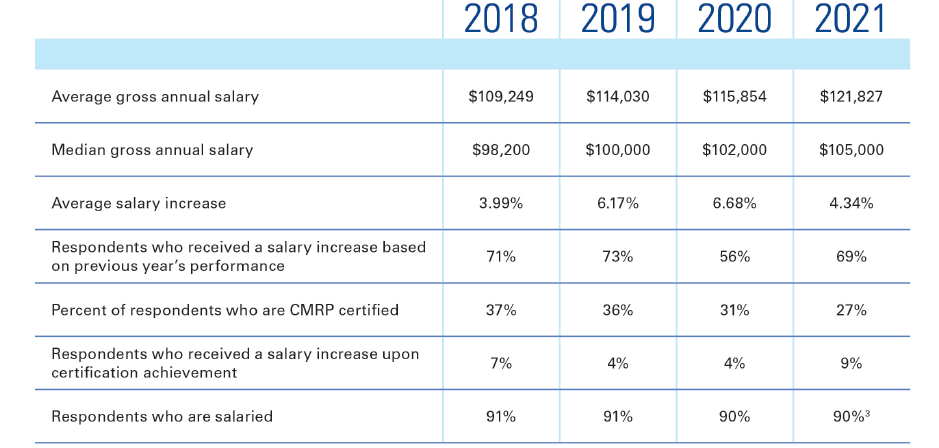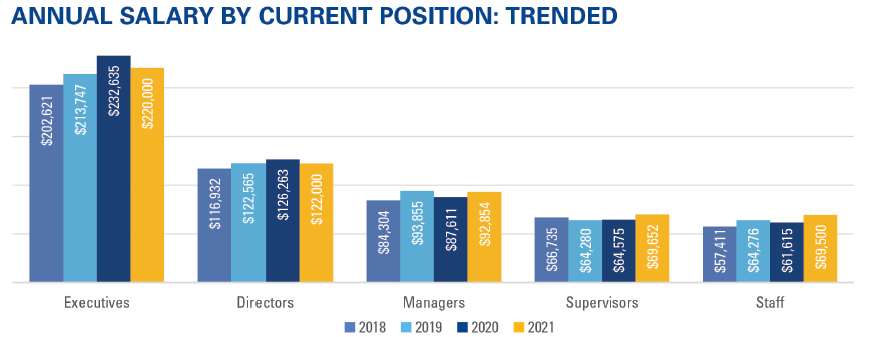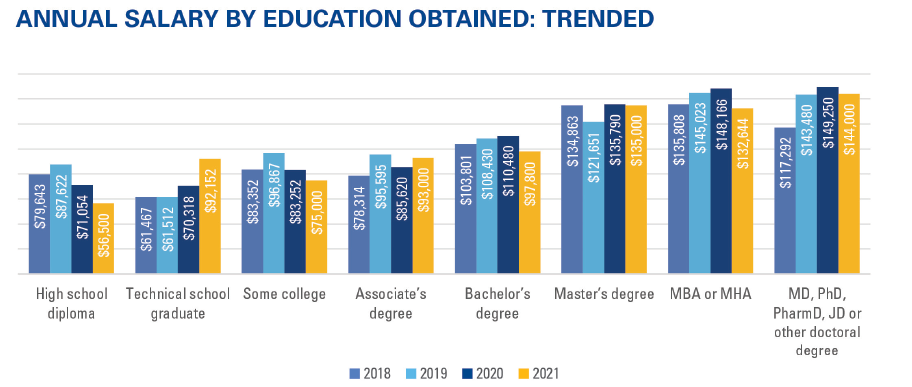Health Care Supply Chain Workforce Increasingly Becoming “Masters” of their own Destiny
Exploring Potential Causes of AHRMM'S 2021 Salary Survey's Shift in Educational Attainment
These past two years have taken a toll on the health care supply chain field, stretching resources, and demanding fast, innovative thinking to ensure that America’s health care systems had the supplies needed for patient care. Today, as we take small, careful steps to recovery and adjustment, many of us are looking to concrete data to inform best practices and to gain insight on how we might better prepare our organizations, as well as ourselves, for the future.
AHRMM has conducted and reported results from its annual salary survey since 2007. AHRMM prepares for each year’s survey by reviewing the previous year’s findings. This review helps us not only revise the salary to meet the ongoing needs of the field, but it also helps us identify interesting patterns that could foreshadow systematic shifts in compensation, career development and workforce trajectories.

This pre-launch review typically illustrates a few expected patterns from year-to-year, including the incremental upward trending of median salary1, and the positive relationship between median reported salary with both level of responsibility and educational attainment. In addition, levels of reported educational attainment are expected to remain stable from year-to-year. For example, in each of the five years before 2021, approximately one-third of respondents reported the bachelor’s degree as their highest level of education. This same period also consistently showed a small but steady year-to-year increase in the proportion of respondents reporting master’s degrees.
This past year (2021) evidenced most of the expected patterns, however, a significant shift in educational attainment was noted at the master’s and bachelor’s levels. Specifically, the proportion of respondents reporting master’s level degrees doubled from 2020 to 2021 (6% vs. 3%). Conversely, the proportion of respondents reporting bachelor’s degrees decreased by 9%. This finding suggests that a significantly higher proportion of respondents earned their master’s degrees over the past year.
Why this increase, and what does it mean for the field and those working within it?
We briefed a small group of AHRMM members volunteers2 on these findings, and then asked them to answer the two questions below, using their experience and insight. Specifically:
- What factors could have facilitated this increase?
- Does this shift in educational attainment signal a systematic increase in educational expectations for the field? Why or why not?
What follows are highlighted themes combined from the results of the 2021 salary survey and these interviews.

What factors may have facilitated this increase?
Interviewees suggested several potential motivators that could explain these findings including job role preservation and accelerated career advancement. Overall, most respondents note that formal (bachelor’s and master’s level) education has always been an important asset in both salary negotiations and promotion decisions, particularly for those individuals’ seeking promotion to manager or director level roles.
Preston Hall, the Director of Materials Management with Indiana Regional Medical Center, explained that advanced educational attainment could also be a way to preserve role seniority during the ever-increasing hospital mergers and acquisitions process. Specifically, a master’s degree could allow someone to get a “leg-up on the competition” and “protect hard won positions against downsizing, especially in the case when smaller hospitals merge with larger hospitals.”
Furthermore, Devin Sumaoang, Director of Supply Chain Transformation with The University of Washington and with 14 years in the field, shared his own mentor’s wisdom when he described how obtaining a master’s degree helps professionals “get there faster” because they can substitute this advanced training for years in the role. Master’s programs include skill building in critical thinking, strategic team building, and financial acumen, all of which are highly valuable to those working within senior strategic and operational roles. He added that this experience may particularly benefit those working within smaller or less complex organizations, since many programs include structured opportunities to practice skills that they might not be able to hone in their current work environments. He also stated that this phenomenon may be further facilitated by the recent increase in more affordable, accredited, online programs.
Interestingly, a generational shift in the workforce and workforce attitudes can also potentially account for a proportion of this increase. Research3 across several fields indicates that younger workforce members are more likely to pursue college degrees than previous generations, and that they may prefer a more expedited career path with multiple organizational jumps, rather than staying with one organization and slowly developing hands-on skills through extended tenure. Thus, as older generations retire out of the field, and the younger generation enters, more and more workers may have attained advanced education and the expectation of a steeper career development trajectory in less time.
We cannot discuss any significant change in health care within the past couple years without also considering potential pandemic impacts. For example, the COVID crisis may have amplified the impact of the generational shift in the workforce (and their accompanying work attitudes and preferences). Specifically, research has shown a marked increase in early retirements of individuals that would have otherwise remained in the health care workforce for another few years. Interviews suggest that a significant proportion of these individuals chose early retirement rather than dealing with the ongoing stress and heightened risk of working during a pandemic. Furthermore, these newly opened leadership opportunities may have encouraged some individuals to participate in advanced education to increase their competitiveness.
Secondly, COVID’s total restructuring of the workforce setting and all the impacts this had on the individual worker and their workday experience certainly can be linked to increased pandemic educational attainment. Widespread, work-from-home scheduling greatly reduced commute time to and from worksite(s) and meetings, and community restrictions banning social events outside of the home left many workforce members with the additional time and attention they needed to concentrate on higher education, especially for those not occupied enough by binge watching Netflix, baking bread, and doing home improvement projects.
Finally, working during the pandemic may have highlighted important departmental skill deficits, particularly for those working within smaller, less complex organizations without dedicated staff possessing critical thinking, financial, and team building skills or more advanced sourcing, contracting and analytical roles. Many workers (and their organizations) may see increasing their knowledge base after this experience to protect against future issues with a pandemic or other health care impacting disaster in the future.

Do we expect to see a lasting shift in educational expectations for the field?
This question is complex on its own, since before we can predict any potential systematic shifts in future educational requirements, we must first understand how the role and hospital environment themselves influence current minimum educational requirements.
The 2021 salary survey asked respondents to report minimum educational requirements for their current role. Results illustrated many expected relationships between minimum requirements and roles, including higher educational requirements for roles with greater responsibilities, higher salaries, and for those reporting to individuals higher up within the organization. However, educational requirements also differed by work setting. Specifically, organizations with larger annual purchasing budgets, larger staffs, and greater numbers of inpatient beds also reported higher educational requirements for the same roles. Conversely, those working within rural areas had significantly less stringent educational requirements than those working within suburban and urban areas. Preston Hall, who works at a hospital within rural Indiana, affirmed this difference when he described the difficulties in finding qualified individuals willing to relocate to rural areas. He explained that organizations like his do not often attract individuals with post-graduate education, instead, they place greater importance on relevant certifications, and that these certifications can illustrate valuable skills and qualify workers for increasingly higher-level roles within his organization.
Survey respondents and those interviewed overwhelmingly agreed that the COVID crisis clearly highlighted the importance of the health care supply chain department. Tina Nam and Tom Griffin, both working with KPMG as experts in the health care supply chain field, further noted the necessity of including health care logistic professionals in high level planning discussions to ensure that organizations are prepared to launch effective strategic planning, sourcing, and procurement activities under all types of strain. Furthermore, the health care supply chain professional must provide insight to the C-suite that allows the entire organization to build greater supply chain resiliency in everyday operations, understand how daily operations may influence further upstream relationships, identify potential risks for disruption, and steers the supply chain team toward financial goals. To successfully fulfill these duties, professionals may now feel the need to develop additional skills in the areas of finance, mathematics, technologies, and organizational improvement.
Given this highlighted emphasis on critical skills, both Tina and Tom suggested that there could be an upward trend in the expectation in formal education. However, they also mentioned that not all organizations may change their role education requirements, particularly those departments working within smaller organizations or more rural settings. Instead, they forecasted that these increased educational demands would be centered within larger, more complex organizations and IDN’s. Furthermore, they also expected that trend would not be permanent, and would eventually slow, because the labor market could only allow for so much.
This exploration has highlighted some interesting potential educational attainment patterns over the past couple of years that may indicate a trend toward higher educational attainment. We know that members value additional insight into field trends to help guide their career advancement decision-making. Our current understanding of this trend has pointed to generational differences and the influence of the COVID crisis. We will continue to monitor these trends through surveys and other data sources and report back to you. Please consider participating in the future AHRMM salary surveys.
1 This past years’ median salary was found to be lower than the year previous. However, this is not surprising as salary increases function as an indicator of overall growth. Thus, this finding underscores the pandemic related financial strain of the field.
2 Volunteers were invited via mass email through the AHRMM platform.
3 This phenomenon is not exclusive to the health care supply chain field, it is well documented across several fields of the American workforce. Future salary surveys may include questions to explore this issue more thoroughly.
2022 Compensation and Satisfaction Survey
Health care providers are encouraged to participate in AHRMM’s 2022 Compensation and Satisfaction Survey between September 19 and October 7. Once the survey closes, a comprehensive report of the results from the 2019, 2020, 2021, and 2022 surveys will be compiled and distributed to AHRMM members. The final report will include a supply chain professional's market value when compared to like facilities, job titles, geographical areas, responsibilities and more. It will allow the health care supply chain professionals to compare how their compensation and benefits match up to their colleagues. AHRMM will distribute the final report to all AHRMM members free of charge and non-members can purchase the report in early 2023.
